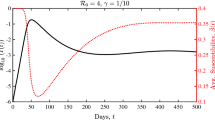Abstract
An ordinary differential equation (ODE) epidemiological model for the spread of a disease that confers immunity, such as influenza, is introduced incorporating both network topology and households. Since most individuals of a susceptible population are members of a household, including the household structure as an aspect of the contact network in the population is of significant interest. Epidemic curves derived from the model are compared with those from stochastic simulations, and shown to be in excellent agreement. Expressions for disease threshold parameters of the ODE model are derived analytically and interpreted in terms of the household structure. It is shown that the inclusion of households can slow down or speed up the disease dynamics, depending on the variance of the inter-household degree distribution. This model illustrates how households (clusters) can affect disease dynamics in a complicated way.
Similar content being viewed by others
References
Ball F (1983) The threshold behavior of epidemic models. J Appl Probab 20: 227–241
Ball F, Neal P (2008) Network epidemic models with two levels of mixing. Math Biosci 212: 69–87
Ball FG, Lyne OD (2002) Epidemics among a population of households. In: Castillo-Chavez C, Blower S, van den Driessche P, Kirschner D, Yakubu A-A (eds) IMA Proceedings 126, mathematical approaches for emerging and re-emerging infectious diseases part II: models, methods and theory, pp 115–142
Ball FG, Sirl DJ, Trapman P (2009) Threshold behaviour and final outcome of an epidemic on a random network with household structure. Adv Appl Prob 41: 765–796
Ball FG, Sirl DJ, Trapman P (2010) Analysis of a stochastic SIR epidemic on a random network incorporating household structure. Math. Biosci. 224: 53–73
Bekessy A, Bekessy P, Komlos J (1972) Asymptotic enumeration of regular matrices. Stud Sci Math Hungar 7: 343–353
Bender EA, Canfield ER (1978) The asymptotic number of labelled graphs with given degree sequences. J Comb Theory (A) 24: 296–307
Brauer F (2008) Compartmental models in epidemiology. In: Brauer F, van den Driessche P, Wu J (eds) Mathematical epidemiology. Springer, Berlin
Britton T, Deijfen M, Lagerås AN, Lindholm M (2008) Epidemics on random graphs with tunable clustering. J Appl Prob 45: 743–756
Diekmann O, Heesterbeek JAP, Metz JAJ (1990) On the definition and the computation of the basic reproduction ratio R 0 in models for infectious diseases in heterogeneous populations. J Math Biol 28: 365–382
Diekmann O, Heesterbeek JAP, Roberts MG (2010) The construction of next-generation matrices for compartmental epidemic models. J R Soc Interface 7: 873–885
House T, Keeling MJ (2008) Deterministic epidemic models with explicit household structure. Math Biosci 213: 29–39
Karrer B, Newman MJE (2010) Random graphs containing arbitrary distributions of subgraphs. Phys Rev E 82: 066118
Lindquist J, Ma J, van den Driessche P, Willeboorsde FH (2010) Effective degree network disease models. J Math Biol 62: 143–164
Miller JC (2009) Percolation and epidemics in random clustered networks. Phys Rev E 80: 020901R
Miller JC (2011) A note on a paper by Erik Volz: SIR dynamics in random networks. J Math Biol 62: 349–358
Neal P (2007) Coupling of two SIR epidemic models with variable susceptibility and infectivity. J Appl Probab 44: 41–57
Newman MEJ (2002) Spread of epidemic disease on networks. Phys Rev E 66: 016128
Newman MEJ (2009) Random graphs with clustering. Phys Rev Lett 103: 058701
Nichols RA, Averbeck KT, Poulsen AG, al Bassam MM, Cabral F et al (2011) Household size is critical to varicella-zoster virus transmission in the tropics despite lower viral infectivity. Epidemics 3(1): 12–18
Pastor-Satorras R, Vespignani A (2001) Epidemic dynamics and endemic states in complex networks. Phys Rev E 63: 066117
Pastor-Satorras R, Vespignani A (2001) Epidemic spreading in scale-free networks. Phys Rev Lett 86: 3200–3203
van den Driessche P, Watmough J (2002) Reproduction numbers and subthreshold endemic equilibria of compartmental models for disease transmission. Math Biosci 180: 29–48
Volz EM (2008) SIR dynamics in random networks with heterogeneous connectivity. J Math Biol 56: 293–310
Volz EM, Miller JC, Galvani A, Meyers LA (2011) Effects of heterogeneous and clustered contact patterns on infectious disease dynamics. PLoS Comput Biol 7(6): e1002042
Author information
Authors and Affiliations
Corresponding author
Rights and permissions
About this article
Cite this article
Ma, J., van den Driessche, P. & Willeboordse, F.H. Effective degree household network disease model. J. Math. Biol. 66, 75–94 (2013). https://doi.org/10.1007/s00285-011-0502-9
Received:
Revised:
Published:
Issue Date:
DOI: https://doi.org/10.1007/s00285-011-0502-9




